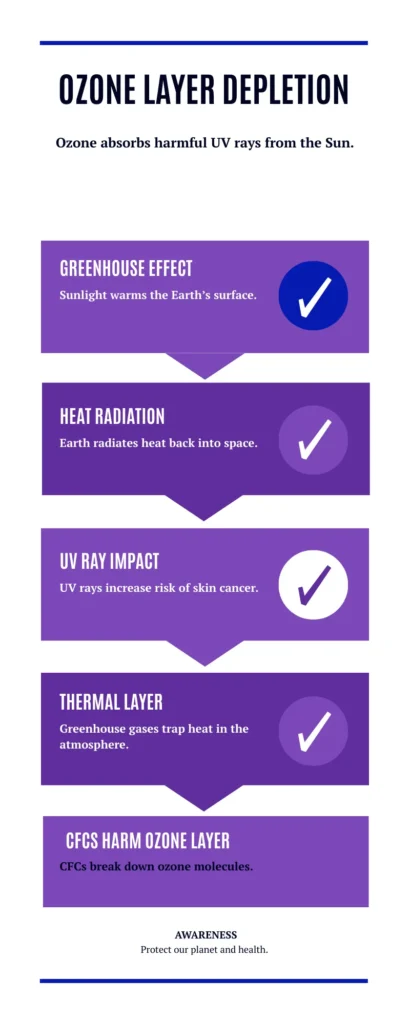People often confuse the greenhouse effect with ozone layer depletion. Both are environmental issues. Both involve the atmosphere. But they are very different in cause, effect, and impact.
This article explains the difference between them in simple words. You’ll also learn why both matter and how they affect life on Earth.
What is the Greenhouse Effect?
The greenhouse effect is a natural process. It helps keep Earth warm enough to support life.
How It Works:
- The Sun sends energy (light) to Earth.
- Earth’s surface absorbs the light and becomes warm.
- The warm surface releases heat (infrared radiation).
- Some heat escapes into space.
- But greenhouse gases like carbon dioxide (CO₂), methane (CH₄), and nitrous oxide (N₂O) trap some heat.
- This keeps Earth’s surface warmer.
Without the greenhouse effect, Earth would be about 33°C colder.
The Problem:
Humans are adding more greenhouse gases to the atmosphere. This is called the enhanced greenhouse effect. It traps more heat and causes global warming.
Main Sources of Greenhouse Gases:
- Burning fossil fuels (coal, oil, gas)
- Deforestation
- Agriculture and livestock
- Industrial activities
What is Ozone Layer Depletion?
The ozone layer is a part of the stratosphere, high above Earth.
It contains ozone gas (O₃), which absorbs harmful UV rays from the Sun. This protects humans, animals, and plants.
The Problem:
Certain man-made chemicals destroy ozone molecules. These include:
- CFCs (chlorofluorocarbons)
- Halons
- Carbon tetrachloride
- Methyl chloroform
These chemicals were used in:
- Refrigerators
- Air conditioners
- Aerosol sprays
- Foam packaging
When released, they float up and break ozone apart. This leads to ozone holes, especially over Antarctica.
The Impact:
- More UV radiation reaches the surface.
- Increases skin cancer and eye damage in humans.
- Harms crops, animals, and marine life.

Key Differences: Greenhouse Effect vs Ozone Layer Depletion
| Feature | Greenhouse Effect | Ozone Layer Depletion |
|---|---|---|
| Layer of Atmosphere | Troposphere (lowest layer) | Stratosphere (upper layer) |
| Main Gases Involved | CO₂, CH₄, N₂O, H₂O | O₃ (ozone), CFCs, halons |
| Main Cause | Fossil fuel burning, agriculture | CFCs and industrial chemicals |
| Main Effect | Global warming, climate change | UV radiation increase, health risks |
| Temperature Impact | Warms the Earth | No warming—allows more UV to enter |
| Global Treaties | Paris Agreement (2015) | Montreal Protocol (1987) |
Common Misunderstanding
Many people think that ozone layer depletion causes global warming. That’s incorrect.
- Ozone depletion increases UV radiation, not temperature.
- Greenhouse gases trap heat, not UV rays.
They are separate issues with different effects, though both are serious.
Are They Connected?
They are different, but indirect links exist:
- Some greenhouse gases like CFCs also damage the ozone layer.
- Warmer temperatures from global warming can affect ozone reactions in the atmosphere.
- Both problems show how human activities harm the atmosphere.
Environmental Impact Comparison
Greenhouse Effect / Global Warming:
- Melting glaciers and sea ice
- Rising sea levels
- More heatwaves and floods
- Stronger hurricanes
- Threats to biodiversity
- Food and water insecurity
Ozone Layer Depletion:
- More cases of skin cancer and cataracts
- Weak immune systems
- Reduced crop yield
- Damage to marine plankton (base of food chain)
- Harm to animals that live in or near the water surface
How the World Responded
Fighting the Greenhouse Effect:
- Paris Agreement aims to limit warming to below 2°C.
- Countries are shifting to renewable energy.
- Efforts to reduce CO₂ emissions through electric vehicles, solar power, and tree planting.
Fixing the Ozone Layer:
- Montreal Protocol (1987) banned ozone-depleting chemicals.
- CFC use dropped by over 98%.
- The ozone layer is recovering slowly.
- Full recovery is expected by mid-21st century.
This proves that global cooperation works when taken seriously.
What You Can Do
To Reduce Greenhouse Effect:
- Use less energy. Turn off lights and appliances.
- Switch to solar energy if possible.
- Use public transport or electric vehicles.
- Eat more plant-based foods.
- Plant trees and support reforestation.
To Protect the Ozone Layer:
- Avoid products with banned CFCs (most are phased out).
- Service your AC and fridge properly.
- Buy ozone-friendly cooling systems.
- Support eco-label products.
Conclusion
The greenhouse effect and ozone layer depletion are both major environmental concerns. But they are not the same.
- The greenhouse effect traps heat and leads to global warming.
- Ozone depletion lets in harmful UV rays, leading to health and ecosystem damage.
Understanding the difference helps us take the right action. We must fight both problems through smarter choices and stronger policies.
Together, we can protect the planet—for ourselves and future generations.
